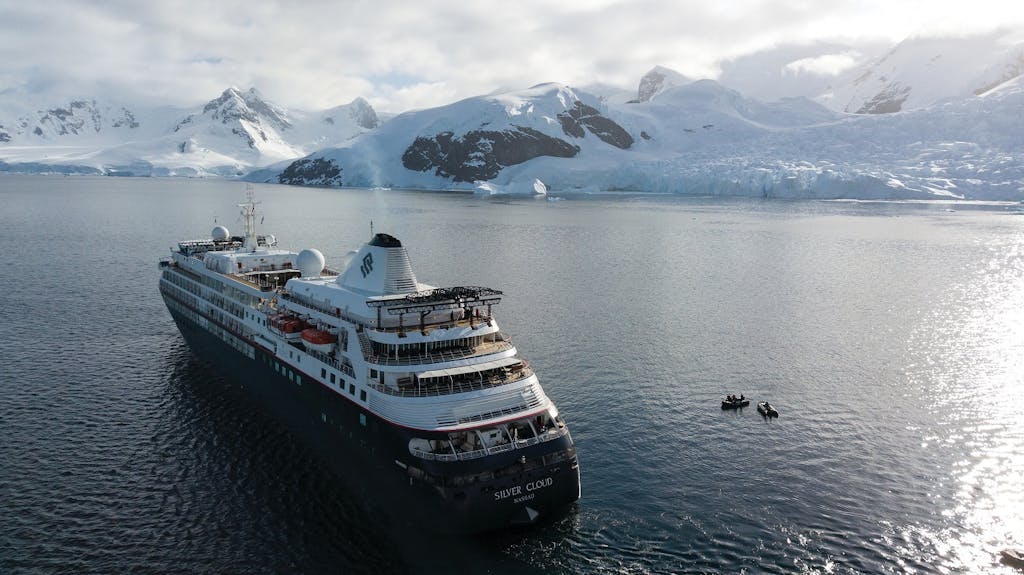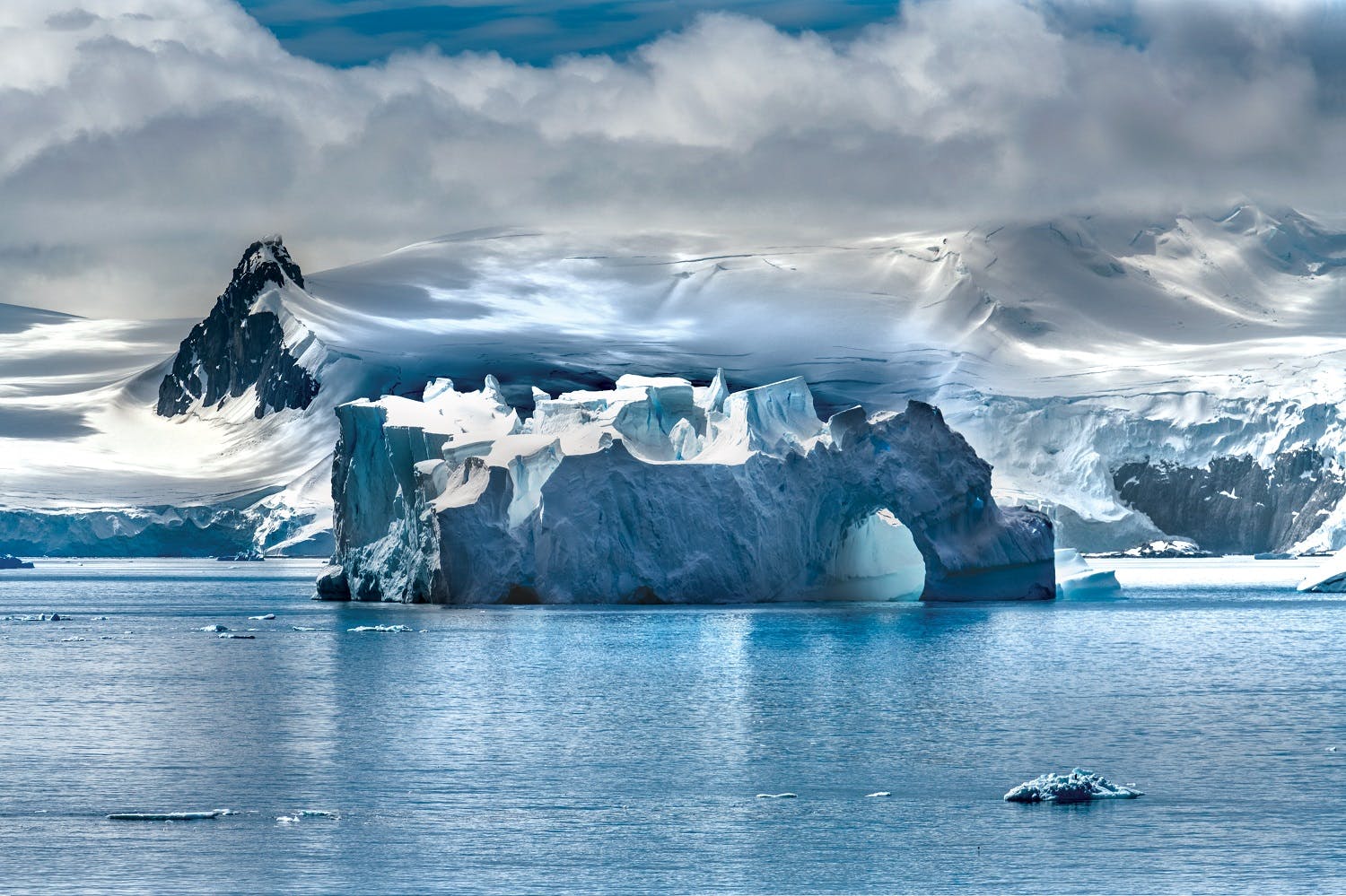How Crossing the Drake Passage Transports You to Another World
I love crossing the Drake Passage. I love this body of water and what it represents. I love the buffer it provides between two worlds and what you see and feel here. This Antarctica cruise shows by far the most exceptional moving body of water on Earth. Unbelievably, about 170 times the flow of every river on the planet passes through this strait, squeezing between the southern tip of South America, the South Shetland Islands and Antarctica. It’s a little over 500 nautical miles across at its narrowest.
This distance may seem vast in size, but it’s also by far the shortest distance to travel to reach Antarctica. For most ships, that means two days and two or three nights each way. The voyage unlocks Antarctica’s most abundant marine wildlife and most magnificent scenery, found in the Antarctic Peninsula region. In the words of Sir David Attenborough, “Nowhere is Antarctica lovelier.”
As part of my job, I’ve spent nearly an accumulated year of my life discovering Antarctica and this patch of ocean. I cross many times each season as a member of Silversea’s Expedition Team, sharing this exciting part of the journey with our guests. I strive to show them what they’ve been expecting, as well as hopefully some things that are new and surprising.
The undeserved infamy of the dreaded Drake

The vast majority of the 750,000 humans who have visited Antarctica have arrived there via this body of water. It’s named after Sir Francis Drake’s supposed foray into the passage, coming through the Magellan Strait and into the Pacific Ocean for the first time in 1578. Drake may or may not have been blown south into this vast body of open water separating Antarctica from the rest of the world, but his name stuck.
The oft-maligned passage has an infamous reputation, so I often hear people saying they won’t visit Antarctica because of a fear of “the dreaded Drake.” This misconception is, sadly, no surprise — travel writers far too often use excessively dramatic language in describing it. These descriptions distract from the real joy that can be experienced on this stretch of an Antarctica cruise.
In reality, when you cross this big mass of water, you experience a couple of days where you can indeed be in the moment. You become acutely aware of where you are on your personal journey. While that might sound a bit poetic, it’s undoubtedly true.

Relishing in the journey
Most crossings of the Drake Passage sail from Ushuaia, the rather charming frontier town nestled where the Andes finally drop into the sea at the very bottom of South America. As you pass along the gorgeous Beagle Channel, little has changed from the time when the remarkable Robert Fitzroy (with a young Charles Darwin joining him for his second voyage) surveyed this waterway for the British Admiralty. You already have South American penguins and sea lions and other wildlife around you in the Beagle soon after leaving the dock in Ushuaia. A couple of hours later, you start seeing your first albatrosses and dolphins. Later that evening, as you head south, you go beyond the rugged islands and channels at the end of the Andes. You’re now in the deep open water of the Drake.

The first half of the Drake leaves both South America and the rest of the world behind. The sense of solitude experienced here encourages you to forget about your busy life, emails, meetings, traffic, flights, politics and media. Antarctica is the last remaining wilderness. We’re now approaching the bicentennial anniversary of the first crossing of the Drake Passage and the first human contact with Antarctica. But it remains one of just a few places on Earth we haven’t conquered. We can visit, but we’re only just touching the edges. Nature and wilderness still rule here, and it deserves our respect.
There’s something gorgeously meditative about crossing this strait with its gradual shifts to the blue-gray seascape stretching away from you. Your companions also change. The first morning after Ushuaia, you find yourself in perhaps the best place in the world to see the Southern Ocean’s most magnificent seabirds. Royal and Wandering Albatrosses — the planet’s largest seabirds and the birds with enormous wingspans — normally accompany the ship for that first morning as we move away from the continental shelf of South America. With them are Giant Petrels and the delightful, painted checkerboard Cape Petrels who will be with us for the whole crossing. These gliding seabirds surf on the air cushions between the waves and slide close alongside us using the air cushion surging from the ship.
Halfway across the Drake, in the middle of deep water, things cool down noticeably as you leave some of the seabirds behind. You are now crossing the Antarctic Convergence, one of the most significant ecological and oceanographic barriers on Earth, and you are nearing Antarctica. Below you are Antarctic krill, the enormous swarms of tiny, shrimplike creatures that feed the abundant wildlife living in these seas.
By this point, almost everyone has their sea legs, and anticipation builds for the second half of the journey across the Drake. You might see your first city-block-sized iceberg and first whales, and you’ll undoubtedly see your first Antarctic brush-tailed penguins.

Making the crossing
Yes, the ship is still moving, and we all do a gentle side-to-side weave as we walk through the corridors. You can’t fight it when the vessel is moving; you roll with it. I, for one, rather like feeling the movement through my feet.
Part of the crossing process is appreciating and working with this enormous mass of water and air. If you look at the weather charts as you go through the passage, you’ll see a string of weather systems rolling off the bottom of South America through the northern Drake. The weather forecast resources we’ve had access to are extraordinary, particularly in the past few years. Captains can plan their routes and adjust their speed and direction to slide through the calmer seas between systems. Some ships, most notably Silver Cloud, can cross the Drake in a day and a half.
Finally, you approach those last couple of hours when the anticipation is building. You might be watching clusters of penguins porpoising alongside the ship, seeing the blows of humpback whales and fin whales, and spotting icebergs. Then suddenly, the South Shetland Islands come into view.
It’s the same view that Edward Bransfield and the sealers, the first human eyes on the seventh continent, saw in 1819. The search for new grounds for fur seals is what ultimately drove these intrepid hunters traveling in their small wooden sailboat to push south. While James Cook had circumnavigated the Antarctic and pushed an incredible distance in that direction forty years earlier, he never actually laid eyes on the continent. Still, he did find South Georgia and reported back large numbers of fur seals on that island, spurring the hunters to go there. After harvesting all the animals, they just kept pushing south.
When you finally get there — and we always arrive at a spot near where those sealers first arrived — you have earned those views. By crossing the Drake Passage and leaving the rest of the world behind, you’re ready for whatever comes next.
Ready to explore this part of the world? Explore these Antarctica cruises.




















